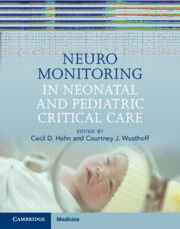Book contents
- Neuromonitoring in Neonatal and Pediatric Critical Care
- Reviews
- Neuromonitoring in Neonatal and Pediatric Critical Care
- Copyright page
- Contents
- Contributors
- Acknowledgements
- Part I General Considerations in Neuromonitoring
- Part II Practice of Neuromonitoring: Neonatal Intensive Care Unit
- Chapter 7 Neonatal Encephalopathy
- Chapter 8 Neonatal Seizures Due to Acute Causes
- Chapter 9 Neonatal Onset Epilepsy
- Part III Practice of Neuromonitoring: Pediatric Intensive Care Unit
- Part IV Practice of Neuromonitoring: Cardiac Intensive Care Unit
- Part V Cases
- Index
- References
Chapter 7 - Neonatal Encephalopathy
from Part II - Practice of Neuromonitoring: Neonatal Intensive Care Unit
Published online by Cambridge University Press: 08 September 2022
- Neuromonitoring in Neonatal and Pediatric Critical Care
- Reviews
- Neuromonitoring in Neonatal and Pediatric Critical Care
- Copyright page
- Contents
- Contributors
- Acknowledgements
- Part I General Considerations in Neuromonitoring
- Part II Practice of Neuromonitoring: Neonatal Intensive Care Unit
- Chapter 7 Neonatal Encephalopathy
- Chapter 8 Neonatal Seizures Due to Acute Causes
- Chapter 9 Neonatal Onset Epilepsy
- Part III Practice of Neuromonitoring: Pediatric Intensive Care Unit
- Part IV Practice of Neuromonitoring: Cardiac Intensive Care Unit
- Part V Cases
- Index
- References
Summary
Neonatal encephalopathy (NE) is the term used to describe persistent neurological dysfunction evident in the first few days after birth. The commonest cause of NE is hypoxia-ischemia, but a similar clinical presentation may occur in other conditions. EEG is essential to grade the severity of neonatal encephalopathy, monitor response to anti-seizure therapy, and to predict outcome early in the neonatal period in infants with NE. Because therapeutic hypothermia is often used in neonatal encephalopathy, the impact of hypothermia on EEG findings is important to consider. EEG evolution and outcome prediction is altered by therapeutic hypothermia. Seizures are common in NE, and seizure burden is also altered by hypothermia. EEG and aEEG can assess severity of NE and predict outcome more accurately than clinical assessment alone. This chapter discusses the various uses of EEG and aEEG in neonatal encephalopathy.
Keywords
- Type
- Chapter
- Information
- Neuromonitoring in Neonatal and Pediatric Critical Care , pp. 103 - 115Publisher: Cambridge University PressPrint publication year: 2022

